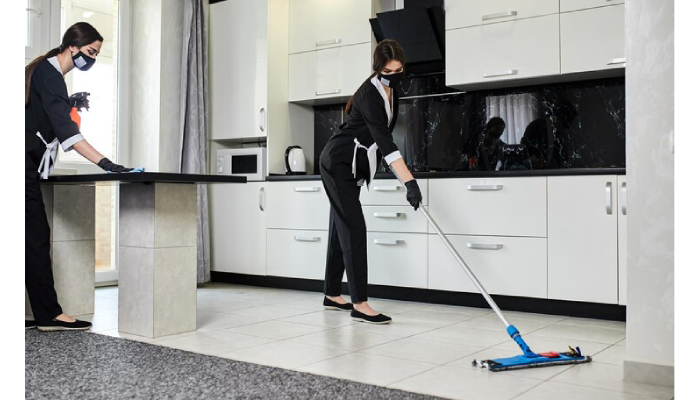
How Kitchen Deep Cleaning Service Prevents Health Hazards?
A kitchen deep cleaning service plays an important role in preventing health hazards by tackling grease buildup that can cause fires and harbor bacteria. Through high-temperature steam and strong degreasers, professionals remove grime from ovens, hoods, and ducts, improving safety. They also sanitize all surfaces thoroughly to prevent cross-contamination, using special cleaners and color-coded tools that keep raw food separate from cooked items. Cleaning floors, drains, and hidden spaces controls pests by removing food sources and entry points. Additionally, deep cleaning removes mold and allergens found in moist areas while reducing harmful bacteria like E. coli. This not only lowers illness risks but helps kitchens meet health regulations for safer cooking environments overall.
Preventing Cross-Contamination with Thorough Sanitization
Cross-contamination happens when raw food touches cooked food or surfaces, creating a risk for foodborne illnesses. A kitchen deep cleaning service tackles this by thoroughly sanitizing all critical areas such as countertops, cutting boards, prep tables, and sinks. High-touch spots like handles, switches, and faucets are carefully cleaned to stop germs from spreading. Using environmentally friendly sanitizers helps minimize chemical residue, making surfaces safer for food prep. Color-coded cleaning tools are often employed to keep raw and cooked food zones separate, reducing the chance of cross-use contamination. Beyond surfaces, sanitizing floors and walls lowers the presence of pathogens throughout the kitchen environment. Removing food particles that harbor bacteria and viruses is also key to keeping the kitchen safe. Additionally, drains and disposal areas are cleaned to prevent bacteria buildup and unpleasant odors. This level of detailed sanitization is essential for preventing outbreaks linked to contaminated kitchen surfaces and helps kitchens consistently meet food safety standards.
Controlling Pests by Cleaning Floors, Drains, and Hidden Areas
Food debris and grease left on floors and in drains create ideal conditions for pests like rodents, cockroaches, ants, and flies. Deep cleaning targets these problem areas by thoroughly scrubbing floors to remove crumbs and sticky residues that attract insects. Drains and grease traps are cleaned to eliminate organic buildup where pests feed and breed. Cleaning hidden spots behind equipment and under counters exposes and removes pest hiding places that often go unnoticed during regular cleaning. Additionally, sealing cracks and gaps around pipes and walls helps block pest entry points, reducing the chance of infestations. Professionals also inspect vents and ducts for signs of pests, ensuring no area is overlooked. Keeping floors and counters dry lowers moisture levels pests need to survive and interrupts their life cycles. Proper waste disposal combined with regular deep cleaning minimizes pest habitats, lowering the risk of contamination on food and kitchen surfaces. These efforts not only improve hygiene but also help kitchens meet health inspections and maintain safe environments for food preparation.
- Food debris and grease attract rodents, cockroaches, ants, and flies.
- Drains and grease traps are cleaned to remove organic buildup that feeds pests.
- Floors are scrubbed to eliminate crumbs and sticky residues that draw insects.
- Hidden areas behind equipment and under counters are accessed and cleaned.
- Sealing cracks and gaps around pipes and walls blocks pest entry points.
- Removing pest habitats lowers contamination risk of food and surfaces.
- Professional cleaning includes inspecting vents and ducts for pest signs.
- Proper waste disposal and regular cleaning disrupt pest life cycles.
- Maintaining dry floors and counters reduces moisture that pests need.
- Effective pest control keeps kitchens passing health inspections and audits.
Sanitizing Refrigerators and Organizing Food Storage
Refrigerators are often overlooked when it comes to deep cleaning, but they can harbor bacteria and mold, especially on shelves, walls, and door seals. A thorough cleaning removes spills, crumbs, and residues that provide breeding grounds for harmful microbes. Cleaning the door gaskets is important not only for hygiene but also to maintain a proper seal, which helps keep the temperature stable and food fresh. Organizing food storage by separating raw meats from ready-to-eat items prevents cross-contamination, a common cause of foodborne illnesses. Sanitizing containers and bins further reduces bacterial growth on stored food. Removing expired or spoiled food is crucial to avoid mold and unpleasant odors that can affect the entire fridge. Additionally, cleaning refrigerator coils improves efficiency and lowers the risk of mechanical breakdowns, while regular defrosting prevents ice buildup that can trap bacteria. Proper labeling and rotating food items help maintain freshness and prevent waste. Cleaning storage racks and cabinets where food is kept also ensures a hygienic environment overall, reducing health risks associated with contamination.
Removing Mold, Mildew, and Allergens from Moist Areas
Mold and mildew often develop in damp spots like sinks, under counters, behind appliances, and other hidden corners of the kitchen. These areas provide ideal conditions for spores to grow, which can trigger respiratory problems and allergic reactions. A deep cleaning service uses specialized cleaners that not only remove existing mold and mildew but also prevent their regrowth by applying anti-microbial treatments. Moisture control is crucial, so drying surfaces thoroughly and inspecting plumbing and seals regularly helps avoid leaks that encourage mold development. Removing allergens like dust mites, pet dander, and mold spores from these moist, hard-to-reach places improves indoor air quality, reducing respiratory discomfort for residents. Cleaning ventilation systems and filters also plays a key role in lowering airborne allergens. For example, cleaning behind and under sinks targets common mold breeding zones that often go unnoticed during routine cleaning. Combined with proper ventilation, these efforts limit allergen buildup over time, creating a healthier kitchen environment.
Reducing Bacterial Load to Cut Foodborne Illness Risks
Bacteria like E. coli and Salmonella often hide in everyday kitchen items such as sponges, dishcloths, and cutting boards, making routine cleaning insufficient to eliminate them completely. Professional deep cleaning uses strong, professional-grade disinfectants that penetrate these surfaces and remove harmful pathogens. Grease traps and drains, common breeding grounds for bacteria, are thoroughly sanitized to break down biofilms, sticky layers where bacteria can survive normal cleaning efforts. Regularly rotating and replacing cleaning tools also helps prevent the transfer of bacteria from one area to another. In addition, deep cleaning focuses on kitchen tools and equipment, ensuring they are free from contamination that could otherwise spread to food. High-touch surfaces like handles, switches, and faucets are disinfected to reduce bacteria transmission among kitchen staff. Refrigerators and storage areas receive special attention to prevent bacterial growth on stored food by keeping these spaces clean and dry. By disrupting bacterial cycles through consistent deep cleaning, kitchens can significantly reduce the risk of foodborne illnesses and maintain a safer environment for food preparation.
Meeting Health and Safety Regulations with Deep Cleaning
Local health codes set strict hygiene standards that kitchens must follow to operate safely. Deep cleaning services help meet these requirements by thoroughly sanitizing all surfaces, including floors, walls, exhaust hoods, and food contact areas, using approved cleaning agents that comply with FDA, USDA, and fire safety regulations. For example, cleaning exhaust hoods and ducts not only reduces grease buildup but also meets fire prevention standards enforced by local authorities. Maintaining detailed cleaning logs documents these efforts, providing transparency and proof of compliance during health inspections. Proper waste removal and pest control are also critical parts of deep cleaning, preventing contamination and ensuring kitchens pass routine health checks without fines or shutdowns. By adhering to sanitation codes through regular professional deep cleaning, kitchens create safer environments that protect both workers and customers while staying aligned with legal safety requirements.
Improving Kitchen Air Quality and Work Environment
Removing grease and dust from kitchen ventilation systems plays a crucial role in improving air circulation, which helps reduce smoke, odors, and airborne grease particles. This not only makes the kitchen more comfortable to work in but also lowers respiratory irritants by eliminating mold and allergens common in damp or neglected areas. A cleaner kitchen environment contributes to less worker fatigue and discomfort, as fresh air and reduced dust improve overall hygiene. Proper lighting combined with spotless surfaces enhances visibility and safety, minimizing the chances of accidents caused by slips or poor awareness. Additionally, reducing pest presence through thorough cleaning boosts staff morale and focus, creating a more professional atmosphere. Regular deep cleaning also ensures floors are less slippery, cutting down the risk of falls and injuries. Together, these factors make the kitchen a healthier, safer place for both food preparation and those working within it.
Scheduling Regular Deep Cleaning for Consistent Hygiene
Maintaining a clean kitchen goes beyond daily wiping and sweeping. Commercial kitchens, especially those with high food volume, benefit from deep cleaning at least twice a year, with some requiring quarterly or even monthly services to keep up with the demands. Residential kitchens also need regular deep cleaning to address overlooked spots like behind appliances and inside vents. Professional cleaners bring specialized tools and cleaning agents that routine efforts can’t match, effectively removing grease, bacteria, and allergens that build up over time. Scheduling these cleanings during low-activity periods helps minimize disruption to kitchen operations. Keeping a documented cleaning schedule not only supports consistent hygiene but also aids in meeting health code requirements. Regular deep cleaning also protects kitchen equipment by preventing grime and buildup that can shorten their lifespan. Over time, frequent professional cleaning reduces the risk of pest infestations by eliminating food sources and hiding places, creating a safer, healthier kitchen environment that supports daily cleaning routines.
Frequently Asked Questions
1. How does a deep kitchen cleaning service reduce the risk of foodborne illnesses?
A deep kitchen cleaning service removes hidden dirt, grease, and bacteria from surfaces and appliances, which helps prevent contamination of food. This thorough sanitation lowers the chance of harmful pathogens spreading and causing illness.
2. In what ways can deep cleaning prevent pest infestations in the kitchen?
Deep cleaning eliminates food residues and grease buildup that attract pests like rodents and cockroaches. By thoroughly cleaning hard-to-reach areas such as behind appliances and inside vents, it reduces the conditions pests need to survive and multiply.
3. Why is targeting hard-to-reach areas important in kitchen deep cleaning for health safety?
Hidden spots often collect grime, grease, and bacteria that regular cleaning misses. These areas can harbor harmful microorganisms that pose health risks, so addressing them during deep cleaning ensures a safer, healthier kitchen environment.
4. How does removing grease and grime from kitchen surfaces improve indoor air quality?
Grease and grime can trap dust and promote mold growth, which negatively affects air quality. Deep cleaning clears these substances, reducing allergens and irritants in the air, which supports better respiratory health for those using the kitchen.
5. What role does sanitizing kitchen appliances play in preventing cross-contamination?
Sanitizing appliances like refrigerators, ovens, and microwaves kills germs that can transfer between foods and surfaces. This helps avoid cross-contamination, lowering the risk of spreading bacteria that cause food poisoning and other health problems.



